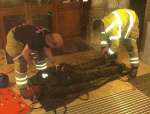 One casualty was an 80kg dummy. Getting it safely up the stairs and into the bell chamber before the exercise started was a challenge in itself.
One casualty was an 80kg dummy. Getting it safely up the stairs and into the bell chamber before the exercise started was a challenge in itself. Did you know? :
In 2024 we hosted a visit from the local fire fighters (see article). They realised that extracting a casualty from the bell chamber could be quite challenging, and since they need to be prepared for any eventuality in their area they asked to run a training exercise in the tower, which took place in March 2025. It was a joint exercise between Wokingham and Bracknell Fire & Rescue service, and theAmbulance service HART (Hazardous Area Rescue Team). The exercise involved two casualties, each in the pit under a bell, and each with different injuries. The objective was to remove them safely, having first worked ho to do so in a difficult and unfamiliar environment. The fire & rescue teams and the ambulance team have different skills and knowledge, and they carry different equipment, The exercise was to test their ability to work together and to deploy their complementary capabilities effectively.
 One casualty was an 80kg dummy. Getting it safely up the stairs and into the bell chamber before the exercise started was a challenge in itself.
One casualty was an 80kg dummy. Getting it safely up the stairs and into the bell chamber before the exercise started was a challenge in itself.
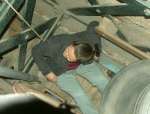 The other casualty was the Wokingham Fire Service Chaplain. She wasn't actually injured but had to behave as if she was. Unlike the dummy she could complain about things like the lifting harness digging into her neck, and the helmet they gave her to protect her head being pushed down over her face so she couldn't see.
The other casualty was the Wokingham Fire Service Chaplain. She wasn't actually injured but had to behave as if she was. Unlike the dummy she could complain about things like the lifting harness digging into her neck, and the helmet they gave her to protect her head being pushed down over her face so she couldn't see.
In both cases the first challenge was to work out how to move the casualties out of the pit, across the bell frame and down the stairs, without making their injuries worse (in one case a spinal/neck injury and in the other a severe leg fracture). There weren't many options and it was interesting watching the teams decide what they were, and how best to proceed.
They also had to bear in mind their own safety. Moving around a bell frame requires care even if you are familiar with it, but most of the team had never been in a bell chamber so it was an alien environment in which an incautious move could have led to a fall, so they had to plan in their own protection as well as that of the casualties.
The teams carry packs of equipment they might need, including ropes, harnesses, lifting gear and a stretchers. They were luck that there are beams above where the casualties were that could support lifting gear,
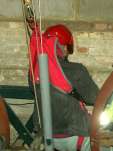 The first casualty was fitted with a lifting harness – not easy within the confines of a bell pit when you have an injured leg. The ropes from her harness went over pulleys slung from the overhead beam, which could be pulled by rescuers in other bell pits. Getting her high enough to move across the top of the adjacent bell proved difficult but they managed it with a bit of help from her good leg. Once they got her to the door she was able to 'bum shuffle' down the narrow spiral stair with her weight carried by the rope, a rescuer behind to guide her and another below to support her injured leg. It would have taken a long time to get her all the way down, so when she reached the clock room they let her get up and stop being a casualty.
The first casualty was fitted with a lifting harness – not easy within the confines of a bell pit when you have an injured leg. The ropes from her harness went over pulleys slung from the overhead beam, which could be pulled by rescuers in other bell pits. Getting her high enough to move across the top of the adjacent bell proved difficult but they managed it with a bit of help from her good leg. Once they got her to the door she was able to 'bum shuffle' down the narrow spiral stair with her weight carried by the rope, a rescuer behind to guide her and another below to support her injured leg. It would have taken a long time to get her all the way down, so when she reached the clock room they let her get up and stop being a casualty.
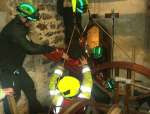 The second casualty had different injuries, and needed to be kept straight. That made lifting out of the pit more difficult, and since the casualty was a dummy it couldn't cooperate. The ambulance team had a special stretcher, like a sheet of stiff plastic that could be rolled up around the casualty to support him in a stiff tube. Unfortunately the bell pit was too narrow to open it let alone get the dummy onto it. So they had to use a different stretcher (the one the dummy came up on). It didn't wrap round so they had to lash the casualty to it, including arms to avoid them catching on anything. The stretcher came out of the pit OK, with a rope on one end going over a pulley like the other one, but then they met another problem. The door is quite narrow, and the stretcher had to be turned head on to fit through it, which was made more difficult by the presence of a bell wheel. Once past that obstacle the stretcher was lowered down the stairs, guided by rescuers and with the weight carried by the rope above.
The second casualty had different injuries, and needed to be kept straight. That made lifting out of the pit more difficult, and since the casualty was a dummy it couldn't cooperate. The ambulance team had a special stretcher, like a sheet of stiff plastic that could be rolled up around the casualty to support him in a stiff tube. Unfortunately the bell pit was too narrow to open it let alone get the dummy onto it. So they had to use a different stretcher (the one the dummy came up on). It didn't wrap round so they had to lash the casualty to it, including arms to avoid them catching on anything. The stretcher came out of the pit OK, with a rope on one end going over a pulley like the other one, but then they met another problem. The door is quite narrow, and the stretcher had to be turned head on to fit through it, which was made more difficult by the presence of a bell wheel. Once past that obstacle the stretcher was lowered down the stairs, guided by rescuers and with the weight carried by the rope above.
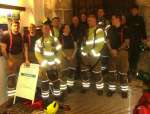 The exercise took longer than planned (2½ hours) so with the clock rapidly approaching 11pm the teams were keen to gather up their equipment and get away, pausing for a team photo before they went.
The exercise took longer than planned (2½ hours) so with the clock rapidly approaching 11pm the teams were keen to gather up their equipment and get away, pausing for a team photo before they went.
As host for the evening, and a civilian observer, I found it interesting to watch a lot of people in a confined and slightly hazardous space, all of them trained but not all having worked together before, collaborating to rescue seriously injured people (albeit not for real on this occasion).
You can see pictures of the exercise by clicking on the thumbnails below
John Harrison (March 2025)
Click each to enlarge and move between pictures using the arrows.
| Back to top | Return to The tower | Return to Home page | Feedback |